Slow Cooker Enchiladas
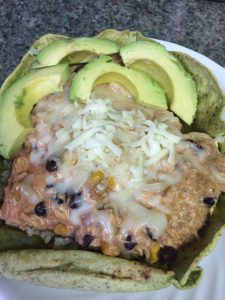
Serves 8. Serving size 3/4 cup.
Ingredients:
1-15 ounce jar of salsa
1 can low sodium whole kernel corn, drained
1 can black beans, drained
1 8-ounce package of low-fat cream cheese
Directions:
- Combine chicken, salsa, beans, and corn in slow cooker.
- Cook on low for 6-8 hours or high for 3-4 hours.
- When cooked shred chicken with two forks and stir.
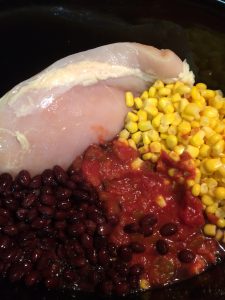
- Cut up cream cheese and stir into the chicken mixture, it will melt.
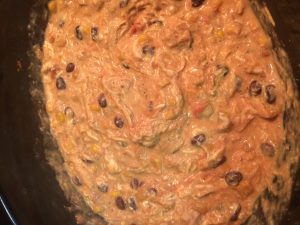
- Serve with whole wheat tortillas, over brown rice, or to top a salad.
- You can top with cheese, olives, cilantro, or avocado.
Preparing for PE Fitness Tests
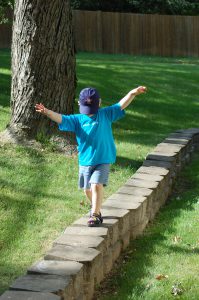
North Carolina public schools encourage healthy growth and development by creating physical activity goals for children to meet in physical education (PE) classes. Even if your child hasn’t started kindergarten yet, you can be preparing them early for the PE requirements.
Listed below are activities for different grade levels that children can participate in to help them meet their PE requirements. Children who haven’t started kindergarten can try the kindergarten activities, and school-aged children can try the activities for their grade level.
Kindergarten
- Goal: basic body control while moving in different settings
- Activities
- Walking, running, hopping, skipping, galloping, chasing, fleeing, dodging
- Try dancing and games like Long Rope Jumping, Individual Rope Jumping, The Bunny Hop, The Hokey Pokey, The Conga, Seven Jumps, The Muffin Man, and The Shoemaker’s Dance
- Catching, throwing, kicking, striking, and dribbling with hand or foot
- Games with verbal cues, Word Walls, Follow the Leader, aerobic activities, tag games, aerobic fitness stations, parachute activities
- Walking, running, hopping, skipping, galloping, chasing, fleeing, dodging
1st Grade
- Goal: develop basic body control, fundamental movement skills, and health-related fitness components such as strength, endurance, and flexibility
- Activities
- Walking, running, hopping, skipping, galloping, chasing, fleeing, and dodging
- In a straight, curved, and zig-zag path; forward and backward, up and down, sideways
- Throwing (under and overhand), catching, kicking, striking, dribbling (with foot and hand)
- Try catching a yarn ball from a self-toss, kicking a stationary ball, volleying a balloon using either hand, rolling and catching with a partner, throwing underhand to targets, overhand throw for distance, and catching and throwing circuit
- Long Rope Jumping, Individual Rope Jumping, Ribbon Wand Exploration, Hoop Spinning, dances (create a dance)
- Control soccer dribble around obstacles, Shadow Dribble, soccer passing in pairs, triangle passing, 3 player kick and score
- Aerobic activities, Crazy Cones, tag, aerobic fitness stations, push-ups, pull-ups, curl-ups, exercise band activities
- Walking, running, hopping, skipping, galloping, chasing, fleeing, and dodging
2nd Grade
- Goal: demonstrate key elements of fundamental movement skills and mature form in locomotive skills
- Activities
- Kicking, throwing, catching, and striking
- Forward, backward, sideways, turn around, half-turn, left, right
- Partner tag, weight transfer and rolls, dance, jump rope, Ribbon Wand Exploration, Animal Balancing Act, Static Balances, Dynamic Balances, Hula Hoop Rolling, control dribble around obstacles (hand and foot)
- Push ups, picking up items in relay, jogging, biking, dancing, stretches, yoga, aerobic and fitness stations exercise, play outside with friends
- Kicking, throwing, catching, and striking
3rd Grade
- Goal: learn and demonstrate more mature movement forms
- Activities
- Dribble with feet, catch from a self toss, throwing, volleying, striking
- Use correct techniques for dribbling, striking, throwing, catching, and kicking in game-like situations
- Combine one locomotor skill (i.e. walking, running, hopping, skipping, galloping, chasing, fleeing, and dodging) with each manipulative skill (i.e. catching, throwing, kicking, striking, and dribbling with hand or foot)
4th Grade
- Goal: combine locomotor and manipulative skills in dynamic situations with body control
- Activities
- Perform combinations of complex locomotor skills and manipulative skills in different physical activity settings
- Create movement skill sequences commonly associated with various sports and activities
- Give and go; passing lanes; spacing; demonstrate changes in speed during straight, curved, and zig zag pathways in dynamic situations; catch an object while traveling (e.g. catch a football pass on the run)
5th Grade
- Goal: show abilities such as improved accuracy in manipulative skills in dynamic situations
- Activities
- Perform combinations of complex locomotor skills and manipulative skills specific to individual, dual and team activities (e.g. hitting a softball)
- Show mature form in combining locomotor and manipulative skills for traditional and non traditional activities (e.g. volleyball, soccer, badminton, softball, basketball)
- Jump rope routines
6th Grade
- Use some specialized skills that are refined and appropriate for modified game play
- Throwing/Catching
- Underhand: bowling, bocce, cornhole, ladder golf
- Overhand: handball, fox tails, softball, football
- Sidearm: frisbee
- Back hand: frisbee
- Striking with feet
- Soccer: ball control, inside food, outside foot, trapping
- Lead Up Games: cone soccer, one-on-one soccer, soccer tag, 4 goal soccer, 4 corner soccer
- Striking with arms and hands
- Underhand: kickball, four-square, volleyball serve, forearm pass, one-bounce volleyball pas
- Overhand: volleyball serve/drive, four-square volleyball (with a beach ball)
- Dribbling: dribble knock-out, relays, right/left, crossover
- Throwing/Catching
- Use movement combinations in rhythmic activities
- Tumbling: jumping/landing and rolls (log, forward, backward, shoulder)
- Dance: line dance (electric slide, cha-cha slide, cupid shuffle, Cleveland shuffle, down south shuffle), square dance (promenade, elbow turn, do-si-do, allemande right), folk dance, multicultural dance
7th Grade
- Goal: apply similar concepts from one sport or movement setting to another
- Activities
- Throwing and catching taught in progression: underhand → overhand → sidearm → backhand → toward non-moving targets → toward moving targets → include in small sided games/activities
- Striking with body parts taught in progression: feet → arms/hands → underhand → overhand → toward non-moving targets → moving targets → include in small sided games/activities
- Kicking: kicking a non-moving object → kicking a moving object → punting
- Arms/hands
- 1 hand underhand → 2 hand underhand → 1 hand overhand
- Serve → forearm pass → set → overhand serve → hit/kill/spike
- Dribbling: 1 hand non-moving → 1 hand moving → 1 hand non-dominant hand non-moving → 1 hand non-dominant hand moving → alternating hands non-moving → alternating hands moving
- Show basic motor skills and complex skills that contribute to movement skills in small sided game situations
- Throwing/Catching
- Underhand: ladder golf, bocce, cornhole, tag rugby
- Overhand: handball, flicker football, softball
- Sidearm: ultimate frisbee
- Back hand: ultimate frisbee
- Striking with Body Parts
- Feet: one-on-one soccer, soccer tag, 4 corner soccer, 2-on-2 soccer (no goalie), 3-on-3 soccer (no goalie)
- Arms/hands
- Underhand: four-square, volleyball underhand pass, one-bounce volleyball pass, prison volleyball
- Overhand: four-square volleyball, volleyball set
- Dribbling: right/left, crossover, behind back, spin, between leg, two-ball, dribble knock-out, relay
- Striking with Equipment
- Table-tennis (grip, serve), wall ball, line volley, floor pong, badminton (grip, serve)
- Throwing/Catching
8th Grade
- Goal: participation for enjoyment and challenge
- Activities
- Throwing/catching: flag football, softball, lacrosse, disc golf, ultimate frisbee
- Striking with Body Parts
- Feet: soccer, speedball, tag rugby
- Arms/hands: volleyball, basketball
- Striking with equipment: table tennis, badminton, floor hockey, softball, lacrosse
- Invasion Games and Keep Away (to learn basic offensive and defensive strategies)
- Use movement combinations in rhythmic activities
- Tumbling: create routines combining 5 or more skills keeping to the beat of music (e.g. floor exercise, balance beam)
- Dance
- Line dance: grapevine, Charleston, cha-cha slide, hip hop moves
- Square dance: promenade, elbow turn, do-si-do, allemande right
- Partner dance: fox trot, waltz, shag, salsa, various ballroom dances
9th Grade
- Goal: get knowledge and skills for movement that provide the foundation for enjoyment, continued social development through physical activity, and access to a physically-active lifestyle
- Activities
- Aquatics, team sports, individual sports, dual sports, outdoor pursuits, self-defense, dance and gymnastics (be able to participant successfully in at least 3)
- E.g. badminton, tennis, golf, bowling, disc golf
- Aquatics, team sports, individual sports, dual sports, outdoor pursuits, self-defense, dance and gymnastics (be able to participant successfully in at least 3)
For more information, visit NC DPI
Share how you’ll help prepare your children for their PE requirements!
Ginger-Mango Salsa
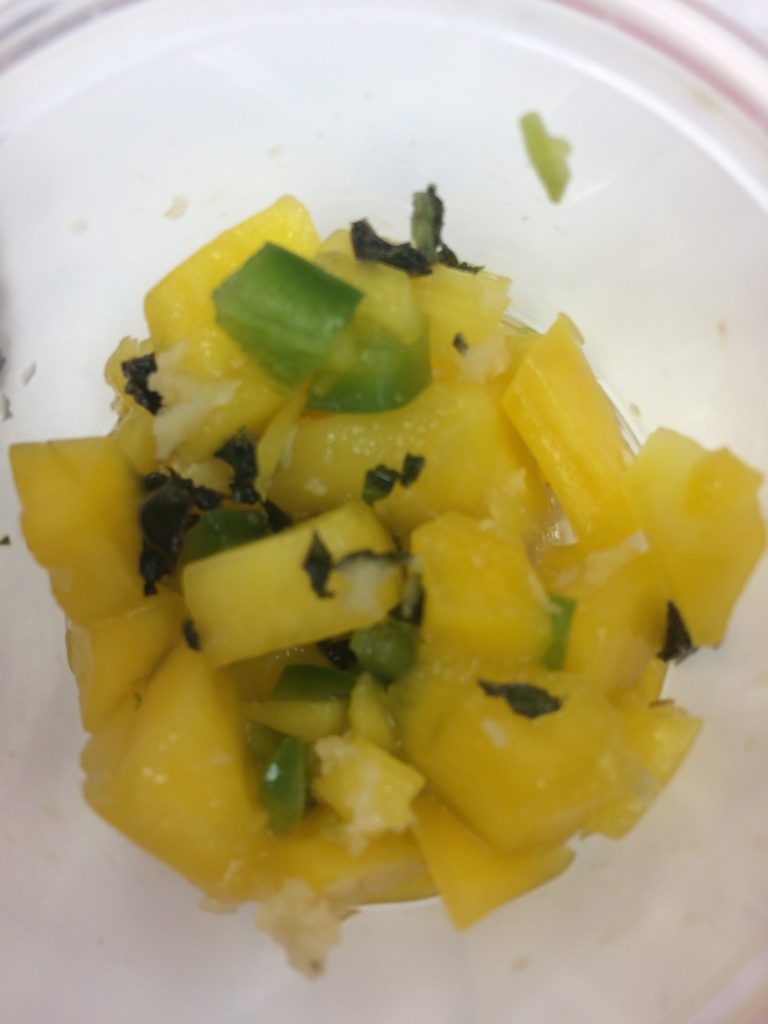 This is a good salsa for fish tacos or as a chip dip. You can substitute pineapple, pear, cantaloupe or other fruit for mango or use a combination if you like.
This is a good salsa for fish tacos or as a chip dip. You can substitute pineapple, pear, cantaloupe or other fruit for mango or use a combination if you like.
Ingredients:
- 1 ripe mango, peeled and diced small
- 1 teaspoon ginger, grated
- 1 tablespoon fresh mint, minced
- 1 jalapeno, minced, carefully remove ribs and seeds for less heat
- Pinch of salt
- 1 teaspoon red wine vinegar
Instructions:
Combine all ingredients. Refrigerate before eating, You can make this ahead of time so flavors can mix better.
What Time Is It, Mr. Fox?

Age-appropriate active games are a great way to help children grow and develop. They can challenge their mind while also challenging their physical fitness! One game your older preschooler or younger school-aged child can play with their friends is “What Time Is It, Mr. Fox?”
To play, your child will need at least 2 other friends to join the game. Have children play in a safe, open area. Choose one player to be Mr. (or Mrs.) Fox. The goal of the game is to get past the Fox without getting caught. To start, have the Fox stand about 20 feet away from the other players with their back turned to the other players. The players then say, “What time is it Mr./Mrs. Fox” The Fox responds with a certain time (whatever the Fox chooses) and the other players should walk forward that many steps. For example, if the Fox says it’s five o’clock, the players should take five steps (any size step) forward. This continues until the Fox responds to “What time is it, Mr./Mrs. Fox” by saying “Midnight!” At that point, the Fox chases the players back to the starting line trying to tag them. The first player that gets tagged by the Fox becomes the Fox for the next game.
To make the game more challenging and help children develop more physical skills, you can have them hop their steps on one foot or even skip forward. For more group games, visit http://m.kidshealth.org/en/parents/games-preschool.html and http://kidshealth.org/en/parents/school-age-games.html.
Who can your children play “What Time Is It, Mr. Fox” with?
Pico de Gallo – Homemade Salsa

Ingredients:
- 2 Roma tomatoes diced
- ½ medium red onion diced
- 1 jalapeno cored and diced
- ½ cup chopped cilantro
- ½ teaspoon salt
Directions:
- Carefully dice and chop ingredients.
- Mix ingredients together in a bowl that can be tightly covered.
- Store in a covered container in the refrigerator.